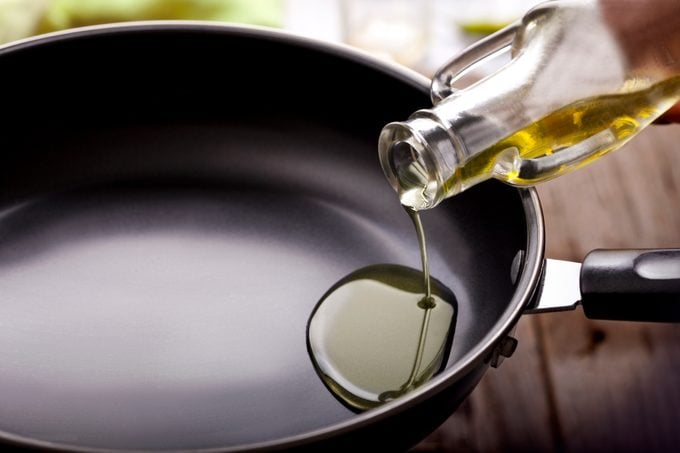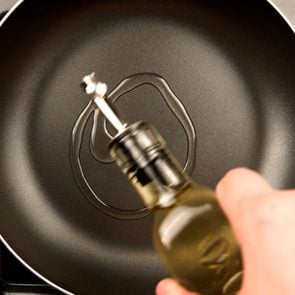What Nutritionists Need You to Know About Smoke Point and Cooking Oils
Updated: May 17, 2021
The smoke point of oils—the temperature at which oils burn—can affect taste and quality. Food experts share what every cook should know.
At some time in the kitchen, you’ve likely seen cooking oil smoke and burn. Watching that smoke billow is an unpleasant sight and smell, forcing you to turn on the exhaust fan and rush to open the windows. But how does it affect the oil’s taste and quality? Is smoking oil really such a bad thing? (Beware of these cooking mistakes that can make food toxic.)
We spoke with top chefs and registered dietitian nutritionists about what the smoke point of oils means, how overheating oil can alter nutrients, and the potentially harmful impacts of burning and smoking oil.
What is an oil’s smoke point?
The smoke point of an oil refers to the temperature at which it begins to smoke—and also degrade in both quality and taste. Typically, the odor of an oil becomes at least somewhat foul once it begins smoking.
“Food can taste burnt if the oil it has been cooked in has started to smoke,” says Lisa Andrews, RD, a registered dietitian in Cincinnati.
An oil’s smoke point affects what you’re able to accomplish with it. For instance, peanut oil has a smoke point of 450 F, which makes it suitable for deep-frying, according to the U.S. Department of Agriculture (USDA). Extra-virgin olive oil, on the other hand, has a smoke point of 405 F; that lower number makes this oil better suited for roasting and baking, says the Institute of Food Technologists.
Smoke points most often become an issue with higher-temperature cooking, such as sautéing, pan searing, stir frying, and pan frying, says Michele Redmond, a chef and dietitian in Scottsdale, Arizona. “It’s important to know the smoke point of an oil because it alters the taste of food—and not in a good way,” she adds. “Knowing some basic smoke point ranges can make you a more efficient, flavor-sensitive cook.” (Get the scoop on the healthiest cooking oils.)

What smoking oil means
Curious about what happens to an oil once it begins to smoke? A lot. “Oil smokes when direct heat applied to it reacts with oxygen enough to burn and create smoke,” says Redmond.
Know, however, that a smoke point of an oil isn’t an exact science. Consider, instead, a smoke point as a range of temperatures. “A single type of oil can have multiple smoke points, depending on the seed variety, processing, fatty acid profile, exposure to air and light, and the amount of trace carbohydrates, minerals, proteins, and aromatic compounds,” says Redmond.
High smoke points
Unfortunately, there’s no easy way to tell from an oils fat content whether it has a higher smoke point. A high smoke point oil can be loaded with good-for-you mono- and polyunsaturated fats, or it can depend on saturated fats. Palm oil, with nearly 7 grams saturated fat, 5 grams monounsaturated fat, and 1 gram polyunsaturated fat per tablespoon, has a high smoke point of 450 F, per the USDA database. The same amount of refined avocado oil, on the other hand, which has a smoke point of up to 500 F, contains just under 2 grams saturated fat, 10 grams monounsaturated fat, and 2 grams polyunsaturated fat. The lower levels of saturated fat and high amounts of monounsaturated fat makes avocado a much more nutritious pick if you need something to fry with.
Then there are also high-oleic oils to consider (oleic refers to omega-9 fatty acids, a type of monounsaturated fat). One popular example is sunflower oil. “Cooking oils high in oleic acids are less sensitive to heat because they are made using plants bred to have more monounsaturated fats and fewer omega-6 polyunsaturated fats,” says Redmond. “For example, traditional sunflower oil is about 20 percent oleic acid, versus 80 percent in high-oleic acid sunflower oil. This makes it more stable for cooking at high heats and gives it a longer shelf life.”
Now, what can happen when oil gets too hot? Let’s investigate.
Smoking oil can change its flavor
Foods readily absorb oil, so anything sitting in smoking oil can absorb acrid and burnt flavors. “The No. 1 reason we choose certain foods is because of taste,” says Lexi Endicott, RD, a registered dietitian in Boise, Idaho. “And foods cooked in burnt oil may taste bitter, burnt, or rancid.”
“Olive and sesame oils have low smoke points,” adds Andrews. “When used in high heat, they will break down and impart an off taste to your food. Avocado and sunflower oil, on the other hand, can tolerate higher temperatures and would be better suited for deep frying or roasting vegetables on high heat.”
Smoking oil can cause your food to catch fire
“If you leave an oil smoking in your pan for too long, you risk it hitting its flash point of catching on fire,” says Redmond. Plus, the clean-up is not fun. As oil thickens, which happens when it catches on fire, says Redmond, it gets sticky and harder to scrub away.
Smoking oil may increase cancer risk
Just as overly grilled BBQ food poses a carcinogenic risk, the same goes for overly heated oil.
“As an oil passes its smoke point, the part of the oil’s triglyceride structure is broken apart from the fatty acids—and free fatty acids, aldehydes, and polar compounds are released,” says Endicott. “As the glycerol continues to heat, it is further broken down to acrolein, an irritating compound to the eyes and throat. Increased acrolein exposure may increase cancer risk, as it disrupts normal RNA [ribonucleic acid] and DNA [deoxyribonucleic acid] function.” That increases the likelihood of cell mutations that can lead to tumor growth.
Another reason why cooking food in smoking oil is a no go? “The higher the temperature that an oil is cooked at, the increased likelihood of free radical production,” says Endicott. “Free radicals are known to alter cellular function, which may lead to increased cancer risk.”
Bottom line: It’s better to not overheat cooking oils. “Healthy fat is incredibly healthy for the health of our cells and cell membranes,” says Isabel Smith, MS, RD, a registered dietitian in New York City. “We want the fat we’re consuming to be high quality and not burnt!”
That doesn’t mean your cancer risk increases the second your pan starts smoking. “A smoking oil doesn’t mean it immediately oxidizes or becomes less stable,” notes Redmond. “The amount of time an oil smokes—and other variables, including the type of fatty acids—can slow these processes. For example, oils high in monounsaturated fats and antioxidants can maintain stability well.”
Smoking oil may heighten risk of heart issues
Those same factors that may impact your cancer risk may also affect your risk of heart disease. “Consumption of polar compounds, aldehydes, and oxidized fats may also increase heart disease risk,” says Endicott. “Oxidized fats cause damage to the endothelial lining of blood vessel, which over time can decrease vascular function and therefore damage proper blood flow.” (Find out the food rules of an anti-inflammatory diet.)
Smoke points for common cooking oils
Here’s a rough guide to smoke points from the cooking tools company, Anova:

Smoking oil prevention tips
To avoid problems when an oil reaches its smoke point, here’s what you can do to decrease your risk.
“Choose oils that best fit the needs of your cooking application,” advises Endicott. You already know that oils with higher smoke points—avocado and peanut oil—are better suited for roasting and sauteing. Unrefined coconut oil is best used for baking and stovetop cooking.
And some oils simply aren’t meant to be heated at all. “Flavor-infused oils or expensive artisan oils are better reserved for finishing,” says Endicott. These include unrefined walnut, pecan, or pumpkin oils. You can use them to drizzle flavor on top of just-out-of-the-oven butternut squash, or they can also be swirled onto freshly made dip.
You might need to experiment, too. “Sometimes, you won’t know the smoke point of an oil until you try cooking with it,” says Endicott. “If you notice an off smell or flavor, or feel a burning sensation in your eyes, your oil has likely exceeded its smoke point.” An oil will often turn clear just before it begins to smoke.
Match your cooking oil to your technique to limit smoke at high heats. Oils with smoke points at or above 350 F pair well with the high temperatures needed for direct-heat techniques like sautéing, pan searing, stir frying, and pan frying. (Find out if canola oil or vegetable oil is healthier.)
The exception to smoking oils
Like life, almost nothing in the kitchen is clear cut. “In some cases, you may desire an oil that begins to smoke just before cooking,” says Redmond. “Cook’s Illustrated tested how a fast pan sear of meat develops better flavors and textures—and cooks faster when added to a just-smoking pan. It’s a bit contrarian, but this is how chefs cook.”



















